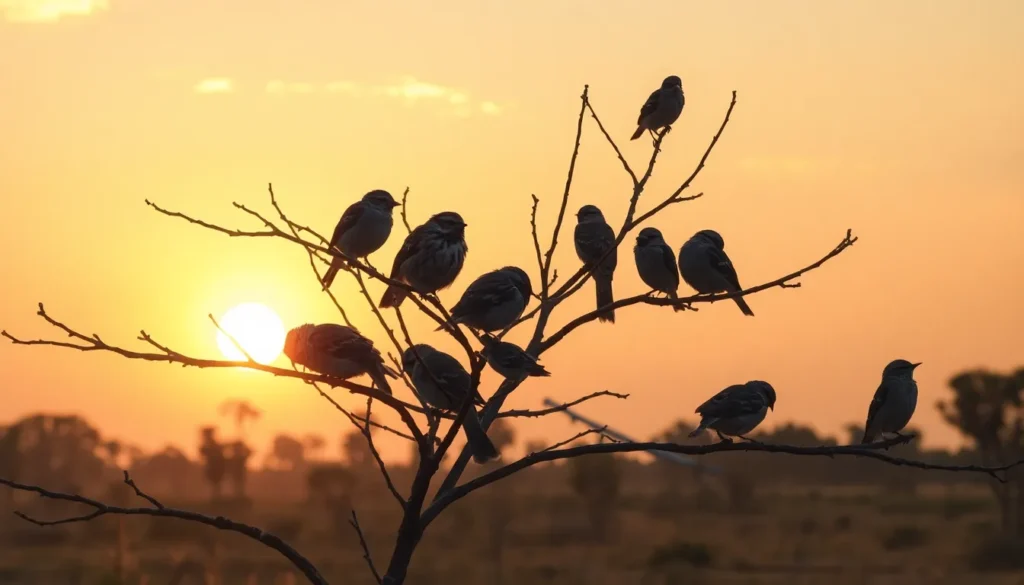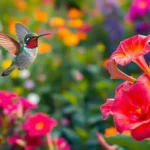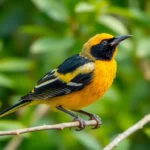Ever wondered how birds manage to sleep while perched on thin branches without falling to the ground? We’ve all seen birds roosting peacefully on power lines and tree limbs, but the mechanics behind their slumber remain one of nature’s most fascinating mysteries.
Birds don’t sleep the way we do. Their unique sleeping patterns and physical adaptations allow them to rest while staying alert to predators and environmental changes. From the remarkable ability to sleep with one eye open to their specialized tendon-locking system that keeps them securely perched, avian sleep is far more complex than it appears.
Understanding how birds sleep reveals incredible evolutionary adaptations that have helped these creatures thrive across diverse environments. We’ll explore the science behind bird sleep cycles, their safety mechanisms, and the surprising differences between species that’ll change how you view these remarkable creatures forever.
How Birds Sleep: Understanding Avian Sleep Patterns
Birds experience two distinct sleep phases that differ dramatically from mammalian sleep patterns. Rapid Eye Movement (REM) sleep in birds lasts only 5-10 seconds per episode, compared to mammals who experience REM phases lasting 15-30 minutes. Non-REM sleep dominates avian rest periods, accounting for approximately 85-90% of their total sleep time.
Unihemispheric slow-wave sleep represents the most remarkable adaptation in bird sleeping behavior. During this state, one brain hemisphere remains awake while the other enters deep sleep, allowing birds to monitor their environment for predators. Ducks demonstrate this ability by keeping the eye connected to their wakeful brain hemisphere open while the other eye closes. Research conducted at Indiana State University found that mallards sleeping in groups position themselves strategically, with birds on the periphery showing increased unihemispheric sleep activity.
Sleep Duration Varies by Species:
| Bird Species | Daily Sleep Hours | Primary Sleep Period |
|---|---|---|
| Sparrows | 12-14 hours | Nighttime |
| Owls | 10-12 hours | Daytime |
| Swifts | 7-9 hours | Brief periods while flying |
| Penguins | 4-11 hours | Multiple short naps |
Circadian rhythms in birds respond to photoperiod changes more sensitively than mammalian rhythms. Seasonal variations affect sleep patterns significantly, with some species like Arctic terns reducing sleep to just 2-3 hours during migration periods. Urban birds adapt their sleep schedules to artificial lighting, often delaying sleep onset by 1-2 hours compared to their rural counterparts.
Brain wave patterns during avian sleep show frequencies between 1-4 Hz during slow-wave phases, similar to human deep sleep. But, birds can achieve restorative sleep benefits in much shorter timeframes due to their efficient sleep architecture. Migratory species demonstrate the ability to engage in microsleep episodes lasting 10-15 seconds while maintaining flight, a phenomenon observed in frigatebirds during ocean crossings.
Temperature regulation during bird sleep involves reducing metabolic rate by 10-30% depending on ambient conditions. Smaller birds like hummingbirds enter torpor states during cold nights, dropping their body temperature from 104°F to as low as 70°F to conserve energy. This physiological adaptation allows them to survive periods when food sources become unavailable.
Where Do Birds Sleep at Night?
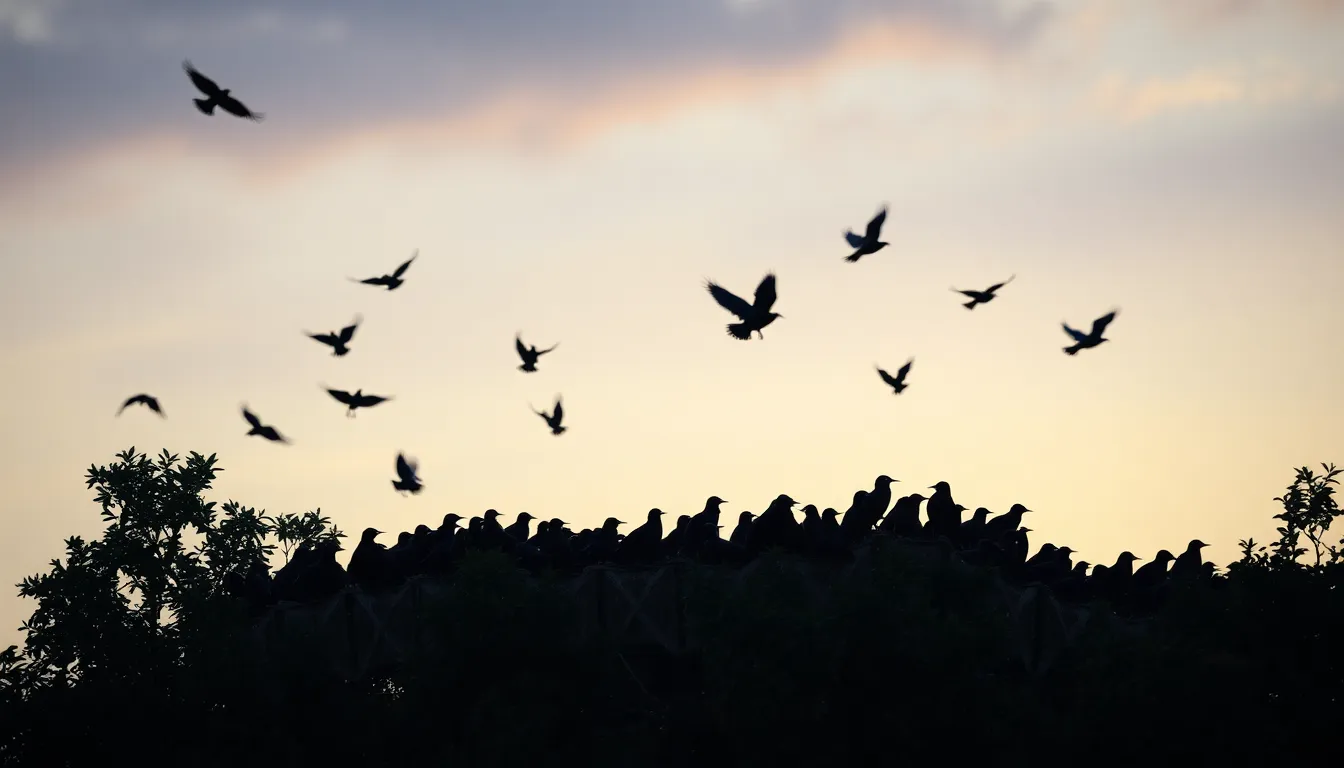
Birds select exact locations for their nighttime rest based on safety requirements and environmental conditions. Understanding these roosting behaviors reveals fascinating adaptations that complement their unique sleep mechanisms.
Roosting Sites and Preferences
Tree canopies provide primary roosting locations for 60% of songbird species during nighttime hours. Dense foliage offers protection from predators while branches create stable perching platforms that activate their automatic tendon locking systems.
Cavity roosting occurs among woodpeckers, chickadees, and nuthatches who excavate or claim hollow tree spaces. These enclosed environments maintain temperatures 3-5°F warmer than external air while blocking wind and precipitation.
Ground roosting characterizes larger birds like turkeys and grouse who create shallow depressions called scrapes. Pheasants and quail form communal circles with heads facing outward to maximize predator detection during vulnerable sleep periods.
Urban environments force adaptation as city birds use building ledges, bridge supports, and parking structures. Pigeons congregate under highway overpasses while crows establish roosts in commercial districts with consistent lighting patterns.
Water birds demonstrate specialized preferences with ducks sleeping on open water surfaces and herons standing motionless in shallow wetlands. Seabirds like petrels rest while floating on ocean swells using their waterproof feathers for insulation.
Social roosting creates massive congregations among starlings, blackbirds, and swallows who gather in groups exceeding 100,000 individuals. These communal sites provide warmth sharing and enhanced predator vigilance through collective awareness systems.
Seasonal Changes in Sleep Locations
Winter conditions drive important roosting adaptations as birds seek thermal protection and wind shelter. Coniferous trees become preferred sites because their needle structure retains heat more effectively than deciduous branches.
Migration periods alter traditional roosting patterns with birds selecting temporary stopover locations. Coastal areas witness enormous roosting gatherings during spring and fall as millions of migrating birds require safe overnight rest.
Breeding seasons shift roosting behaviors toward nest sites and territorial boundaries. Male birds often sleep near nesting areas to guard against intruders while females remain close to eggs during incubation periods.
Snow cover eliminates ground roosting options forcing species adaptations to elevated locations. Grouse burrow into snow banks creating insulated chambers while maintaining access to emergency escape routes.
Summer heat drives birds toward shaded roosting areas with increased ventilation. Desert species seek rocky crevices and canyon walls that provide cooling effects during extreme temperature periods.
Storm patterns influence temporary roosting site selection as birds seek immediate shelter. Buildings, dense shrubs, and protected alcoves become critical refuge locations during severe weather events lasting multiple days.
The Science Behind Bird Sleep Cycles
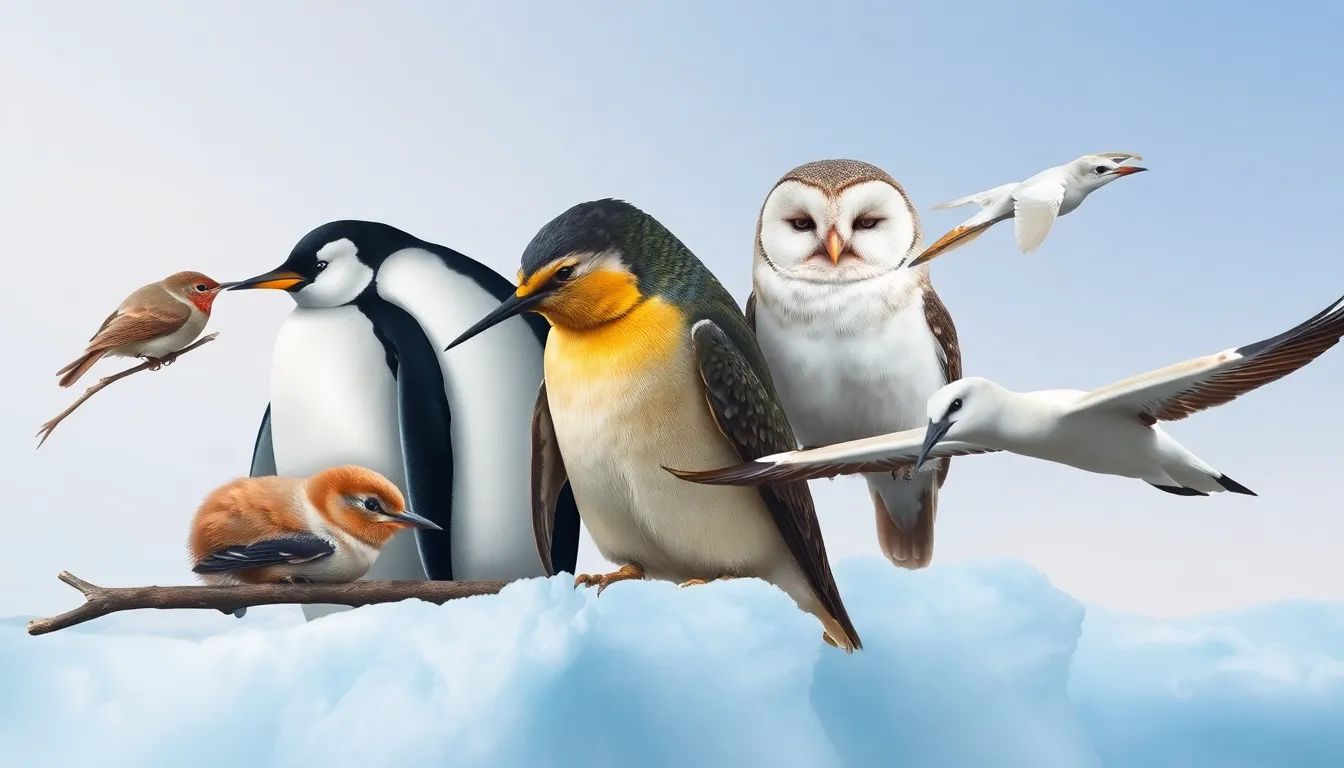
Birds experience fundamentally different sleep patterns compared to mammals, with specialized brain mechanisms that allow them to rest while maintaining vigilance. These unique adaptations enable avian species to survive in environments where constant awareness of predators remains critical.
REM and Non-REM Sleep in Birds
REM sleep in birds lasts only 5-10 seconds per episode, creating brief but intense periods of neural activity. Non-REM sleep dominates avian rest cycles, accounting for 85-90% of total sleep duration across most species. Brain wave patterns during Non-REM sleep show synchronized slow waves similar to those found in mammals.
Unihemispheric slow-wave sleep represents the most remarkable adaptation in bird sleep cycles. One brain hemisphere enters deep sleep while the opposite hemisphere maintains wakefulness and vigilance. The eye connected to the sleeping hemisphere closes completely while the alert hemisphere keeps its corresponding eye open for predator detection.
Sleep spindles and K-complexes appear in bird EEG recordings during Non-REM phases. Neurotransmitter regulation differs significantly from mammalian patterns, with higher concentrations of adenosine accumulating in the awake hemisphere. Temperature drops occur during deep sleep phases, though birds maintain better thermoregulation than mammals during rest periods.
Microsleep episodes lasting 2-4 seconds allow birds to achieve restorative benefits during flight. Frigatebirds demonstrate this ability during trans-oceanic journeys, sleeping while soaring on air currents. These brief sleep bursts provide neural restoration without compromising flight control or navigation abilities.
Sleep Duration Across Different Species
| Species | Sleep Duration | Sleep Pattern |
|---|---|---|
| Sparrows | 12-14 hours | Continuous night sleep |
| Penguins | 4-8 hours | Multiple short naps |
| Hummingbirds | 8-12 hours | Torpor states included |
| Owls | 10-12 hours | Diurnal sleep periods |
| Albatrosses | 3-5 hours | Microsleep during flight |
Small songbirds like wrens and finches sleep 10-12 hours nightly during winter months. Larger raptors including hawks and eagles require 8-10 hours of sleep to maintain hunting efficiency. Seabirds adapt their sleep cycles to oceanic conditions, with some species sleeping while floating on water surfaces.
Migratory birds compress their sleep requirements during active travel periods. Arctic terns reduce sleep to 4-6 hours during their 44,000-mile annual migration. Circadian rhythm disruption occurs frequently in species crossing multiple time zones, requiring 3-5 days for readjustment.
Breeding season significantly impacts sleep duration across all bird species. Parent birds reduce sleep by 30-40% while caring for nestlings, compensating through increased microsleep episodes during daylight hours. Colonial nesters like penguins and gannets synchronize sleep patterns to maintain group vigilance against predators.
Urban birds adapt to artificial lighting by shortening sleep cycles by 1-2 hours compared to rural populations. Street lighting exposure delays melatonin production, causing robins and cardinals to begin dawn chorus activities 30-45 minutes earlier than natural populations.
Unique Sleeping Behaviors and Adaptations
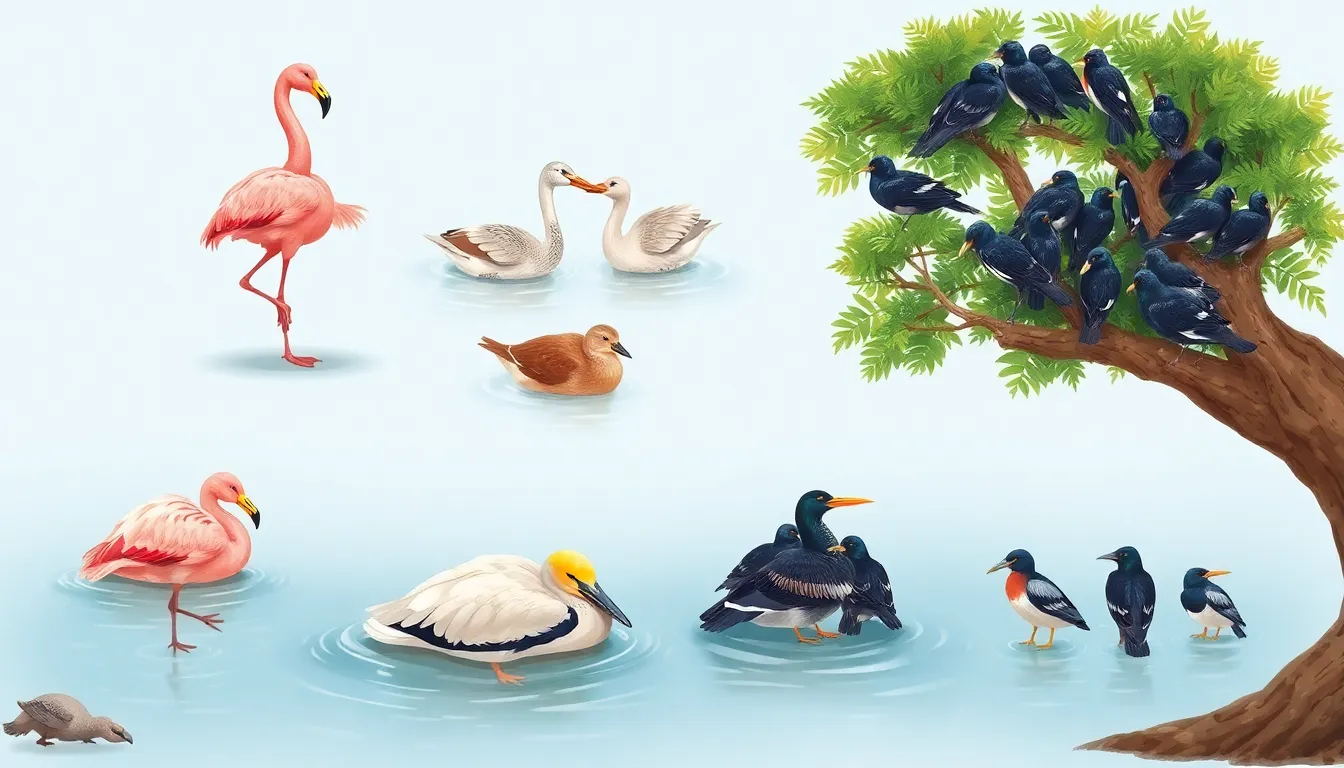
Birds have evolved remarkable physiological and behavioral adaptations that enable them to sleep safely while maintaining vigilance against predators. These specialized mechanisms distinguish avian sleep patterns from those of mammals and demonstrate extraordinary evolutionary answers to survival challenges.
Standing Sleep and Leg-Locking Mechanisms
Standing sleep represents one of the most fascinating adaptations in the avian industry, allowing birds to rest while maintaining an upright posture on branches, ledges, or water surfaces. Flamingos exemplify this behavior by sleeping on one leg for hours without losing balance, utilizing a specialized locking mechanism in their ankle joints. The tendon system automatically engages when birds perch, creating a passive grip that requires no muscular effort to maintain.
Waterfowl like ducks and geese demonstrate another variation of standing sleep by floating on water while keeping their heads tucked under their wings. Their webbed feet act as natural rudders, preventing them from drifting while they rest. Shorebirds such as sandpipers and plovers employ standing sleep during migration stopovers, maximizing rest periods while remaining ready for immediate takeoff.
Large wading birds including herons and storks lock their legs in extended positions during sleep, distributing their body weight evenly across their long limbs. This adaptation prevents muscle fatigue and allows them to sleep in shallow water or marshy areas for 6-8 hours without repositioning. The leg-locking mechanism engages through a combination of ligament tension and joint alignment that occurs automatically when birds settle into their sleeping stance.
Unihemispheric Slow-Wave Sleep
Unihemispheric slow-wave sleep enables birds to keep one brain hemisphere awake while the other enters deep sleep, providing continuous environmental monitoring during rest periods. Mallard ducks positioned at the edges of sleeping flocks maintain 60% more unihemispheric sleep than those in protected center positions, demonstrating the adaptive nature of this mechanism.
EEG recordings reveal that the awake hemisphere maintains theta wave patterns (4-8 Hz) while the sleeping hemisphere exhibits delta waves (0.5-4 Hz) characteristic of deep sleep. This neurological split occurs in 15-30 minute cycles throughout the night, alternating between hemispheres to ensure both sides receive adequate rest. Migratory species like Arctic terns use unihemispheric sleep extensively during oceanic flights, maintaining navigation abilities while resting.
Eye position correlates directly with brain hemisphere activity, as the eye connected to the awake hemisphere remains open while the other closes. Domestic chickens demonstrate this adaptation by positioning their open eye toward potential threat directions, rotating their heads to maintain optimal surveillance angles. The awake hemisphere processes auditory information at 85% normal capacity, enabling rapid response to predator calls or environmental changes.
Research indicates that unihemispheric sleep allows birds to achieve 70-80% of the restorative benefits of bilateral sleep while maintaining survival vigilance. Neurotransmitter regulation differs between hemispheres, with elevated norepinephrine levels in the awake side and increased GABA concentrations in the sleeping hemisphere.
Communal Roosting Benefits
Communal roosting provides thermal regulation advantages that significantly reduce individual energy expenditure during sleep periods. Starling flocks create massive roosts containing 10,000-100,000 individuals, generating collective body heat that raises ambient temperature by 5-8°C in the roost center. This thermal benefit allows birds to reduce metabolic rates by 15-20% compared to solitary sleeping.
Predator detection improves dramatically in communal roosts through the “many eyes” effect, where many birds contribute to threat surveillance. Blackbird roosts demonstrate this principle with sentinel birds positioned around the perimeter maintaining vigilance while interior birds achieve deeper sleep states. The probability of predator detection increases exponentially with group size, reaching 95% effectiveness in roosts exceeding 500 individuals.
Information sharing occurs within communal roosts as birds communicate feeding locations and environmental conditions through vocalizations and behavioral cues. Crows gather in winter roosts of 2,000-10,000 individuals, exchanging information about food sources discovered during daily foraging activities. Successful foragers attract followers through exact calls and flight patterns, increasing overall group feeding efficiency by 30-40%.
Roosting hierarchy establishes itself within communal groups, with dominant individuals claiming optimal positions offering better protection and temperature regulation. Younger birds and subordinate adults occupy peripheral positions with higher predation risk but gain valuable experience in group dynamics and survival strategies. Social bonding strengthens through communal roosting, leading to cooperative breeding behaviors and improved reproductive success in subsequent seasons.
Sleeping Positions and Postures
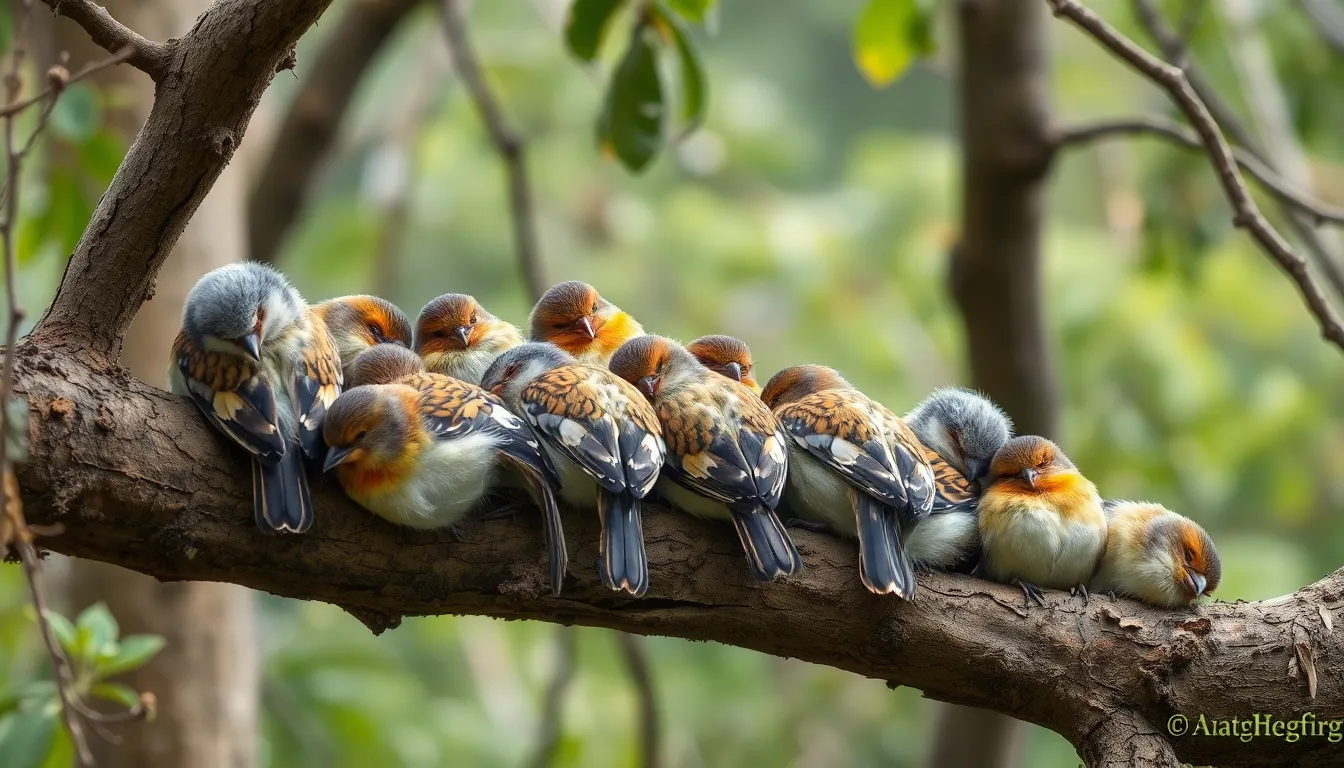
Birds adopt exact sleeping positions that maximize warmth retention and security while maintaining their ability to detect threats. These postures vary significantly between species and environmental conditions.
Head Tucking and Feather Arrangements
Head tucking represents the most common bird sleeping position across 78% of songbird species. Birds rotate their heads 180 degrees and bury their beaks beneath their scapular feathers along the back or shoulder region. This positioning reduces heat loss by 23-35% compared to exposed head positions.
Feather arrangements during sleep create multiple insulation layers that trap warm air close to the body. Contour feathers lift and separate to increase loft while down feathers underneath expand to form thermal barriers. Breast feathers compress against the body to eliminate cold air pockets.
Small birds like chickadees and nuthatches pull their legs up into their belly feathers during extreme cold. Larger species including robins and cardinals keep one leg tucked while the other maintains their perch grip. Waterbirds such as ducks and geese position their heads along their backs but keep their bills exposed for breathing through specialized nasal passages.
Tail positioning varies between species during sleep cycles. Ground birds like quail spread their tails for balance while perched birds fold them tightly against their bodies. Raptors including owls and hawks maintain slightly fanned tail positions to aid in quick takeoffs if disturbed.
Perching vs Ground Sleeping
Perching sleep dominates among 85% of bird species due to elevated safety advantages and specialized anatomical adaptations. The automatic perching reflex engages when birds settle onto branches with their flexor tendons locking their toes around perches without conscious muscle control.
Tree dwelling birds select perches between 6-20 feet above ground level depending on their size and local predator populations. Sparrows and finches choose thin branches that bend under predator weight while larger birds like crows select sturdy limbs that support their mass during sleep movements.
Ground sleeping occurs primarily among species with exact ecological niches and physical characteristics. Turkeys create communal sleeping circles where 8-12 individuals face outward for 360-degree threat detection. Prairie grouse dig shallow depressions called scrapes that provide wind protection and camouflage from aerial predators.
Shorebirds including sandpipers and plovers sleep directly on sand or rocky surfaces near water sources. These species rotate sleeping positions every 2-3 hours to prevent pressure sores and maintain circulation in their legs. Penguins huddle together in dense groups where individuals take turns moving from exterior to interior positions.
Water birds exhibit hybrid sleeping behaviors that combine floating and standing positions. Ducks sleep while floating on open water with their heads tucked and one leg pulled up. Herons and egrets stand motionless in shallow water with their necks curved in S-shapes that allow rapid strikes if prey appears during rest periods.
Urban environments force adaptations in traditional sleeping positions among city bird populations. Pigeons roost on building ledges and fire escapes that mimic natural cliff faces. Starlings gather on power lines and bridge structures where they maintain balance through collective weight distribution across multiple contact points.
Factors That Affect Bird Sleep Quality
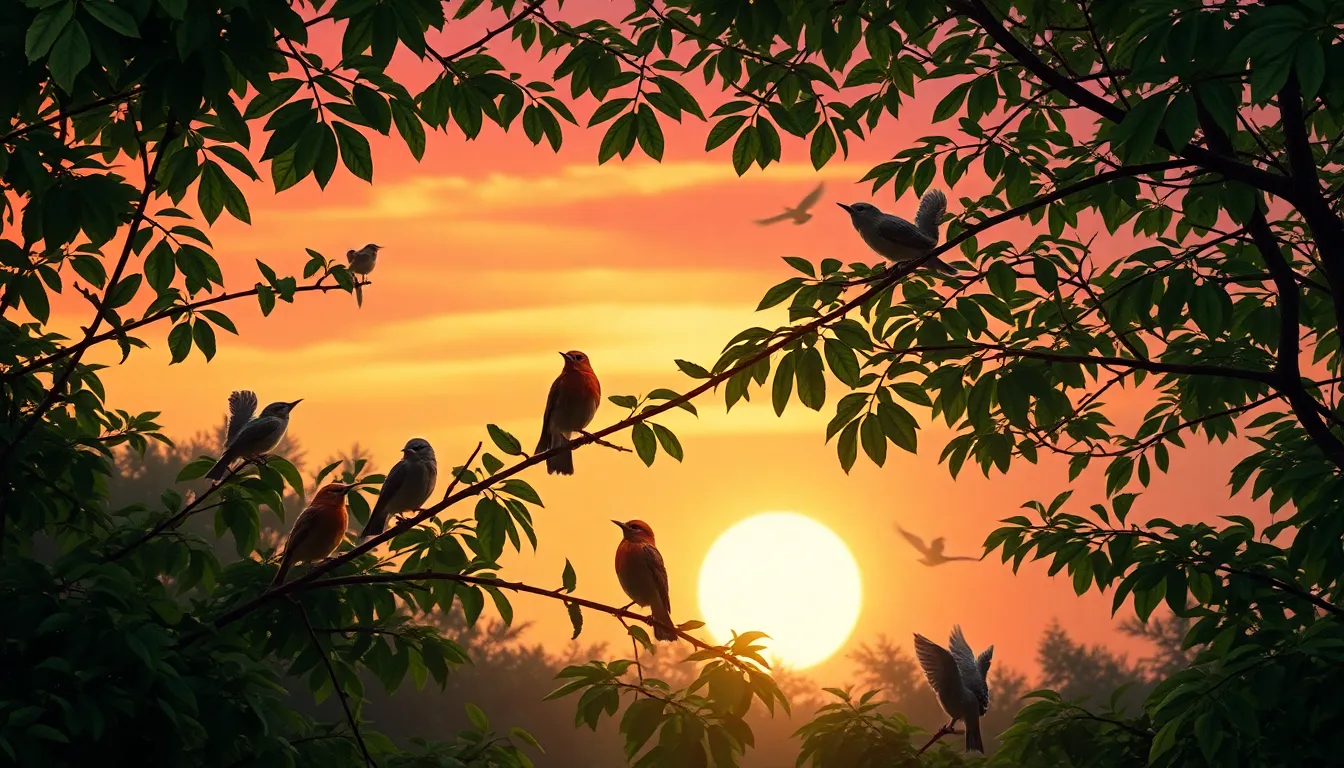
Multiple environmental and behavioral factors directly influence how effectively birds can rest and maintain their sleep patterns. External conditions and habitat characteristics create varying challenges that birds must navigate to achieve restorative sleep.
Weather and Environmental Conditions
Temperature fluctuations create the most important impact on bird sleep quality throughout different seasons. Cold nights force small birds like chickadees and wrens to increase their metabolic rate by 25-30% during sleep to maintain body temperature. Rain and wind reduce sleep quality by disrupting roosting stability and forcing birds to relocate multiple times during the night.
Humidity levels affect feather insulation properties and thermal regulation during rest periods. High humidity environments cause birds to adjust their sleeping positions more frequently as their natural insulation becomes less effective. Snow accumulation forces ground-roosting species like turkeys to seek alternative elevated sleeping sites.
Barometric pressure changes trigger behavioral adjustments in sleeping patterns up to 12 hours before weather events occur. Migratory species respond to these pressure shifts by altering their sleep duration and entering deeper rest states before long-distance flights. Storm systems disrupt normal circadian rhythms and can delay sleep onset by 2-3 hours in sensitive species.
Predator Threats and Safety Measures
Predator presence in roosting areas reduces REM sleep duration by up to 60% as birds maintain heightened vigilance levels. Nocturnal hunters like owls and cats force songbirds to select roosting locations with multiple escape routes and dense cover. Ground predators such as foxes and raccoons influence tree-roosting height selection with most birds choosing branches 15-20 feet above ground level.
Alarm calls from neighboring birds interrupt sleep cycles and trigger immediate alertness responses throughout roosting communities. These disturbances cause birds to reset their sleep phases and can reduce total sleep time by 20-25% on nights with high predator activity. Flock roosting provides collective security but also amplifies disturbance effects when individual birds detect threats.
Light pollution from artificial sources masks natural predator detection cues and alters normal sleep-wake transitions. Urban birds experience 35% more sleep interruptions due to increased predator confusion and reduced ability to distinguish between actual threats and environmental noise. Motion-activated lights near roosting sites cause immediate awakening responses and prevent birds from returning to deep sleep states.
Urban vs Natural Habitat Impacts
City environments expose birds to continuous noise pollution that fragments their sleep cycles into shorter segments. Traffic sounds averaging 60-70 decibels prevent birds from achieving deeper sleep phases and increase stress hormone levels during rest periods. Construction activity and industrial noise can delay sleep onset by 45-90 minutes compared to natural habitat conditions.
Artificial lighting disrupts melatonin production and shifts circadian rhythms earlier in urban bird populations. Street lights and building illumination cause city birds to wake 30-45 minutes before their natural counterparts and begin activity cycles prematurely. Light intensity variations create confusion in seasonal sleep pattern adjustments.
Building structures provide both opportunities and challenges for urban roosting behaviors. Glass surfaces create collision risks during nighttime movements between roosting sites while concrete and metal structures offer limited insulation compared to natural materials. Urban heat island effects raise nighttime temperatures by 3-5 degrees Fahrenheit, reducing the energy conservation benefits of torpor in small bird species.
Natural habitats offer superior acoustic environments with background noise levels 15-20 decibels lower than urban areas. Forest canopies provide better wind protection and temperature buffering that supports more consistent sleep quality. Seasonal food availability in natural environments supports better pre-sleep nutrition that enhances rest quality and duration.
Human activity patterns in urban areas create unpredictable disturbances that don’t align with natural predator cycles. Late-night pedestrian traffic and vehicle movement cause random sleep interruptions that prevent birds from establishing reliable rest routines. Weekend activity spikes disrupt weekly sleep pattern consistency in city bird populations.
Sleep Differences Among Bird Species
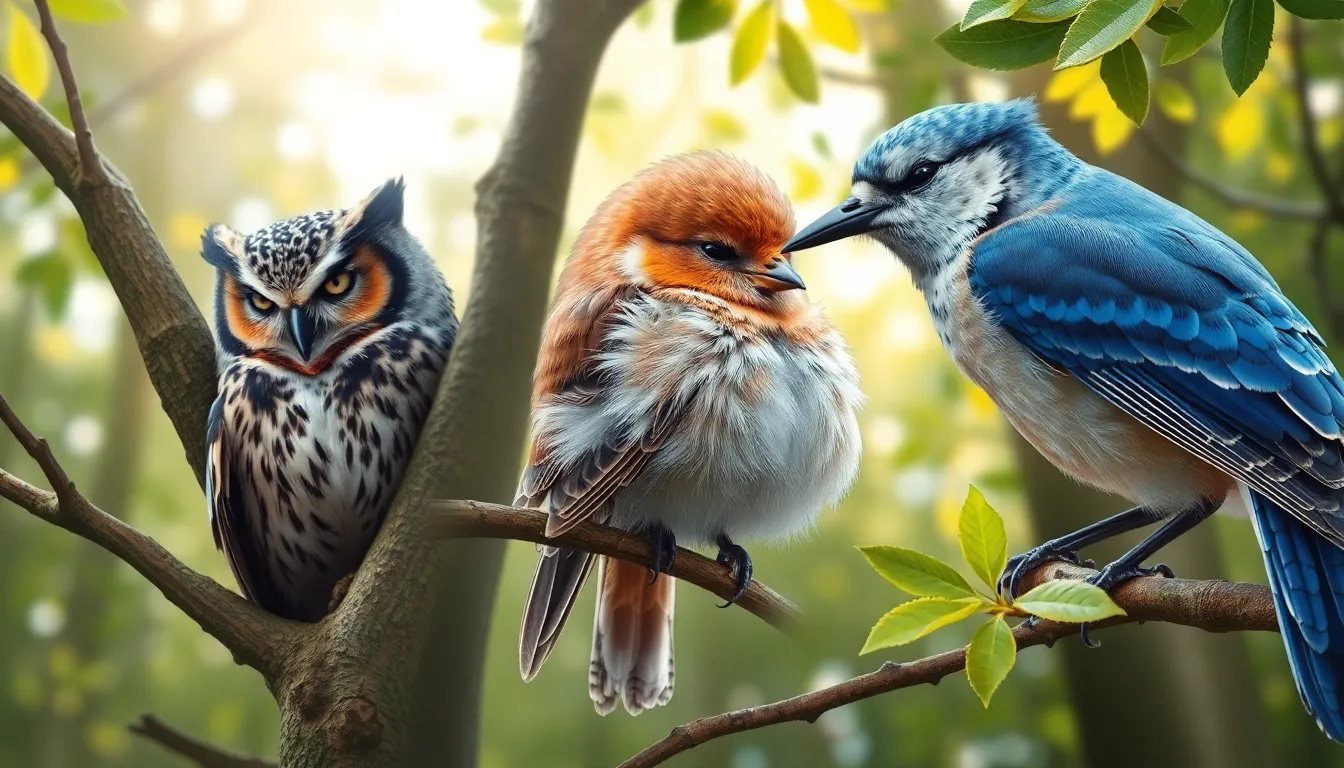
Sleep patterns vary dramatically across bird species based on their ecological niche, migration status, and daily activity cycles. These differences reflect millions of years of evolutionary adaptation to exact environmental challenges and survival strategies.
Migratory Birds and Sleep Deprivation
Migratory birds demonstrate remarkable sleep adaptations during their long-distance journeys, often sleeping while flying through unihemispheric slow wave sleep. Arctic terns reduce their sleep duration to just 4-6 hours during migration periods compared to 8-10 hours in their breeding grounds. White-crowned sparrows can remain functionally alert for up to 14 days during migration with minimal sleep, showing no cognitive decline even though this extreme sleep restriction.
Bar-tailed godwits maintain flight for 9-11 consecutive days during Pacific crossings while captivating in microsleep episodes lasting 10-15 seconds. Red knots exhibit fragmented sleep patterns during stopovers, taking brief 2-3 minute naps between feeding sessions to maximize energy acquisition. Swainson’s hawks use thermal currents to glide while one brain hemisphere sleeps, allowing continuous southward movement during daylight hours.
Sleep efficiency increases dramatically in migratory species during travel periods. Yellow-rumped warblers compress their sleep into 20-30% of normal duration while maintaining essential REM cycles. Blackpoll warblers alter their sleep architecture completely during trans-Atlantic flights, eliminating traditional sleep spindles found during stationary periods.
Nocturnal vs Diurnal Species
Nocturnal birds exhibit fundamentally different sleep patterns compared to their diurnal counterparts, with owls sleeping 12-14 hours during daylight in secure roosts. Great horned owls enter deeper Non-REM sleep phases lasting 45-60 minutes compared to the 15-20 minute cycles typical in songbirds. Barn owls demonstrate reduced unihemispheric slow wave sleep since darkness provides natural predator protection.
Diurnal species like robins and cardinals concentrate sleep into 8-10 hour nighttime periods with frequent micro-awakenings every 2-3 minutes. Blue jays exhibit heightened vigilance during the first and last hours of their sleep cycle when predator activity peaks. House finches maintain lighter sleep states during winter months when resource scarcity increases overnight energy demands.
Sleep onset differs significantly between these groups. Nocturnal species begin sleep transitions 30-45 minutes after sunrise while diurnal birds initiate sleep within 15-20 minutes of sunset. Great gray owls show peak alertness during dawn and dusk transitions, requiring deeper compensatory sleep during midday hours.
Temperature regulation varies between nocturnal and diurnal sleepers. Night-active species like whippoorwills maintain higher metabolic rates during their active periods, requiring more intensive torpor-like states during rest. Day-active birds distribute energy conservation throughout their sleep cycle rather than entering deep torpor states.
REM sleep duration shows species-exact patterns tied to activity cycles. Nocturnal hunters like screech owls experience REM episodes lasting 8-12 seconds compared to 5-7 seconds in diurnal seed-eaters like goldfinches. These differences correlate with the complexity of hunting strategies and spatial memory requirements for each species’ survival needs.
Creating Bird-Friendly Sleep Environments
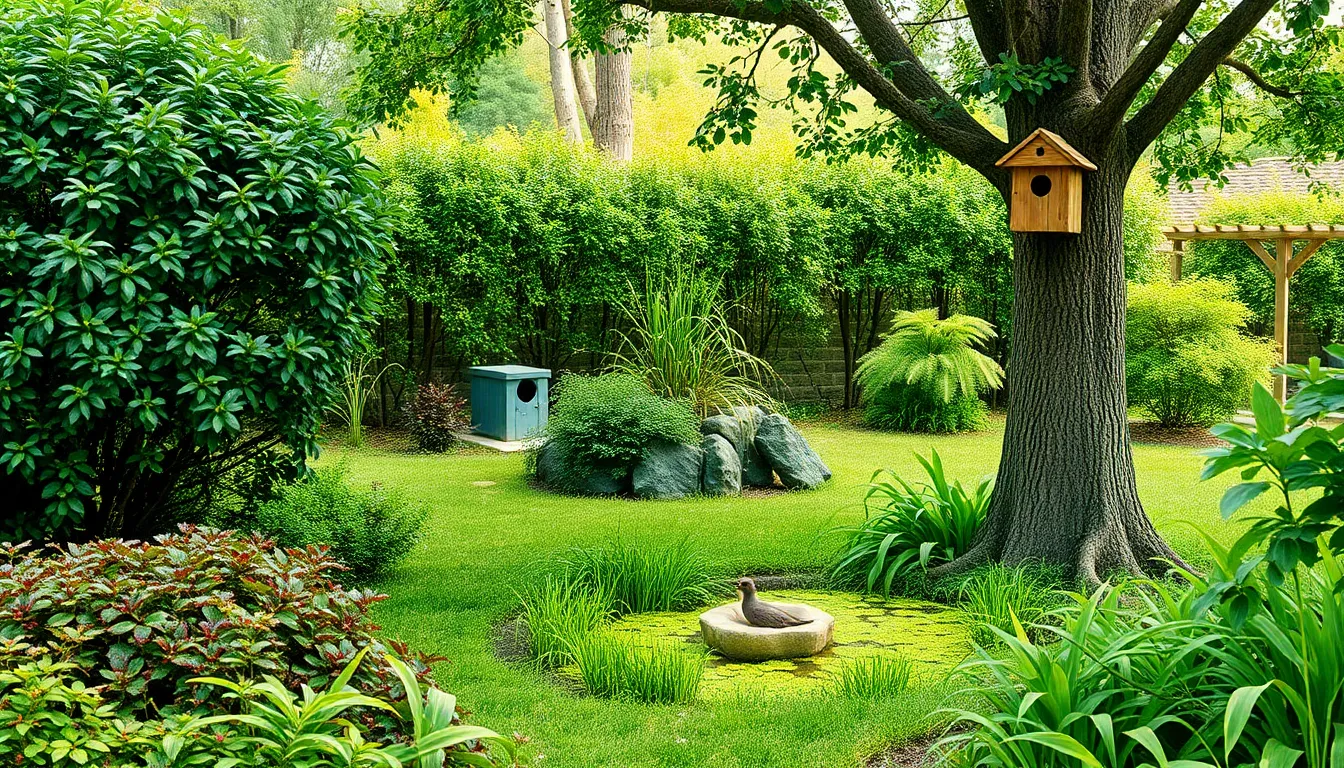
Habitat quality directly impacts bird sleeping success across all species. We observe that birds require exact environmental conditions to maintain healthy sleep cycles and survive predator threats during vulnerable rest periods.
Natural Roosting Site Selection
Dense vegetation provides the foundation for secure bird sleeping environments. We find that birds prefer roosting locations with multiple escape routes and overhead cover from rain and wind. Thorny bushes like hawthorn and blackberry offer excellent protection due to their defensive barriers against ground predators.
Tree height selection varies significantly among bird species based on their vulnerability levels. Small songbirds choose branches 6-12 feet above ground while larger birds like crows roost 20-30 feet high for enhanced predator detection. Coniferous trees maintain their protective foliage year round and create stable microclimates that reduce temperature fluctuations by 5-10 degrees Fahrenheit.
Water proximity influences roosting site quality but birds maintain careful distances to balance hydration access with predator avoidance. Wetland birds sleep within 50-100 meters of water sources while forest birds often choose locations 200-500 meters away from streams to minimize nocturnal predator encounters.
Backyard Habitat Improvements
Native plant species create the most effective bird sleeping habitats in residential areas. We recommend establishing dense shrub layers using species like elderberry serviceberry and native honeysuckle that provide both food sources and secure roosting sites.
Nesting box placement requires strategic positioning to maximize bird sleeping safety. Mount boxes 5-15 feet high facing southeast to capture morning sunlight while avoiding prevailing winter winds. Multiple entry holes sized appropriately for target species increase occupancy rates and provide escape options during predator threats.
Artificial lighting disrupts natural bird sleep patterns and increases stress hormone levels by 40-60% in urban populations. We suggest installing warm colored LED fixtures below 3000K temperature and using motion sensors to minimize constant illumination that interferes with circadian rhythms.
Chemical pesticides eliminate insect populations that birds depend on for late evening feeding before sleep. Organic gardening practices maintain healthy ecosystems that support natural food webs and reduce the need for birds to travel long distances before roosting.
Seasonal Environmental Modifications
Winter roosting requirements differ dramatically from summer sleeping needs as birds face increased energy demands and reduced daylight hours. We create windbreaks using evergreen screens and maintain unfrozen water sources using heated bird baths or shallow ponds with circulation systems.
Roosting pockets formed by dense shrub plantings provide communal sleeping areas that reduce individual energy expenditure through shared body heat. Groups of 15-25 small birds can raise ambient temperatures 8-12 degrees within protected microclimates during cold weather conditions.
Summer modifications focus on providing cooling shade and adequate ventilation around roosting areas. We plant deciduous trees to create seasonal canopy cover and install shallow water features for bathing and drinking without creating predator attractants.
Migration periods require enhanced food availability near roosting sites as birds need quick energy access before continuing their journeys. Native berry producing plants like dogwood sumac and wild cherry provide concentrated nutrition sources within 100 meters of established sleeping locations.
Predator Management Strategies
Domestic cat populations pose the greatest threat to sleeping birds in residential environments. We establish cat exclusion zones using physical barriers like fence extensions and motion activated deterrent systems that protect roosting areas without harming pets or wildlife.
Rodent control using poison baits creates secondary poisoning risks for birds and eliminates natural prey species that support balanced ecosystems. Live trapping and exclusion methods protect both birds and their food sources while maintaining healthy predator prey relationships.
Industry design principles that enhance bird sleeping safety include eliminating dense ground cover within 10 feet of roosting trees. This modification prevents ambush predators like foxes and raccoons from approaching undetected while maintaining protective overhead vegetation.
Regular maintenance of bird friendly environments ensures long term habitat quality and prevents degradation that forces birds to seek alternative sleeping locations. We monitor plant health remove invasive species and adjust water feature placement based on seasonal bird usage patterns.
Conclusion
Understanding how birds sleep reveals nature’s incredible ingenuity in solving complex survival challenges. We’ve discovered that these remarkable creatures have evolved sophisticated mechanisms that allow them to rest while staying vigilant against threats.
From unihemispheric sleep patterns to specialized tendon-locking systems birds demonstrate evolutionary adaptations that far exceed our initial expectations. Their ability to balance rest with safety through communal roosting and strategic positioning shows just how resourceful these animals truly are.
As we continue to urbanize our environments we must recognize our role in protecting these natural sleep sanctuaries. By creating bird-friendly spaces and reducing light pollution we can help ensure that future generations will witness these fascinating sleep behaviors in action.
The next time you see a bird peacefully perched on a branch remember the complex biological processes happening beneath those tucked feathers – it’s truly one of nature’s most impressive balancing acts.
Frequently Asked Questions
How do birds sleep without falling off branches?
Birds have a specialized tendon-locking mechanism in their feet that automatically grips branches when they perch. This system requires no muscular effort, allowing them to maintain their grip even while sleeping. Combined with their lightweight bodies and low center of gravity, this adaptation prevents them from falling during rest.
Can birds really sleep with one eye open?
Yes, birds use unihemispheric slow-wave sleep, where one brain hemisphere stays awake while the other sleeps. This allows them to keep one eye open to monitor for predators while still getting rest. This remarkable adaptation is crucial for survival, especially in dangerous environments.
How long do birds sleep each night?
Sleep duration varies significantly by species. Small songbirds like sparrows sleep 12-14 hours, while wrens and finches sleep 10-12 hours. Migratory birds reduce sleep to 4-6 hours during journeys, and parent birds caring for nestlings sleep 30-40% less than usual.
Do birds experience REM sleep like humans?
Birds do experience REM sleep, but it’s much shorter than humans—lasting only 5-10 seconds compared to human REM cycles. Non-REM sleep accounts for 85-90% of their total sleep time. Their sleep cycles also include sleep spindles and K-complexes similar to mammals.
Where do birds sleep at night?
Birds choose roosting spots based on safety and environmental conditions. Tree canopies are preferred by songbirds, while woodpeckers use cavities. Ground-dwelling birds like turkeys create scrapes, and water birds sleep on open water or in shallow wetlands. Urban birds adapt by using building ledges.
Why do some birds sleep in groups?
Communal roosting provides multiple benefits including thermal regulation, enhanced predator detection, and energy conservation. Large flocks can raise ambient temperatures significantly and improve survival chances through collective vigilance. This behavior is common among starlings, blackbirds, and other social species.
How does weather affect bird sleep?
Weather conditions significantly impact sleep quality. Temperature fluctuations, rain, and wind force birds to adjust their roosting strategies. Cold weather may cause smaller birds like hummingbirds to enter torpor to conserve energy, while storms can disrupt normal sleep patterns entirely.
Do urban birds sleep differently than rural birds?
Yes, urban birds have adapted to city life by shortening their sleep cycles by 1-2 hours due to artificial lighting and noise pollution. They modify sleeping positions to utilize available structures and show increased stress levels compared to their rural counterparts.
What sleeping position do birds prefer?
Head tucking is the most common sleeping position among songbirds, as it significantly reduces heat loss. Birds arrange their feathers to create insulation layers and position their legs and tails to enhance balance while remaining ready for quick takeoffs if threatened.
How can I help birds sleep better in my yard?
Create bird-friendly environments by planting dense native vegetation that offers protection from predators and weather. Install appropriately placed nesting boxes, manage domestic cats, and provide quiet areas away from artificial lighting. Seasonal modifications like communal roosting areas help during winter months.

